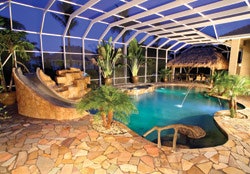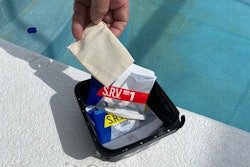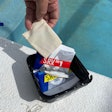
It's not just that chloramines stink - they smell vaguely of urine - but a growing body of research casts suspicion on chloramines as a health hazard, particularly the concentrated chloramines that can build up in indoor pools.
Last year, researchers at Catholic University of Louvain in Brussels, Belgium, compared the health of 733 teenagers between the ages of 13 and 18 who swam in chlorinated indoor and outdoor pools for various amounts of time with that of 114 adolescents who swam mostly in pool water ionized with concentrations of copper and silver. In children with allergic sensitivities, swimming in chlorinated pools significantly increased the likelihood of asthma and respiratory allergies, while swimming in non-chlorinated pools did not.
The researchers also discovered, in a separate study, that 36 percent of 400 children who were exposed to swimming (either indoors or out) before they were two years old developed bronchiolitis - a common lung inflammation, often caused by a virus - while only 24 percent of those who didnt swim at that age developed the same condition. Children exposed to indoor swimming before age two also were three times more at risk of developing bronchiolitis than their non-indoor-swimming peers. And 15 percent of those swimmers with bronchiolitis were diagnosed with asthma as they got older, compared to only 4 percent among non-swimming children.
The only plausible explanation, Catholic University researchers concluded, is that chloramines - a mixture of chlorine, ammonia and other organic byproducts of the human body such as hair, sweat and urine that hover above the water's surface where swimmers inhale - cause changes in a swimmer's airway and promote the development of allergic reactions. "It is probably not by chance that countries with the highest prevalence of asthma and respiratory allergies are also those where swimming pools are the most popular," Alfred Bernard, a toxicologist involved in both studies, told the Reuters news service.
Other studies have backed this up. The L.A. Times ran an article on Sept. 12, 2010 citing three studies published in the Environmental Health Perspectives journal stating that people who regularly swim in indoor pools could be exposing themselves to health risks from chloramines.
In one of the studies, blood, urine and exhaled air samples from 49 non-smokers were taken before and after they swam in a chlorinated indoor pool for 40 minutes. Researchers found "concentrations of four biomarkers suggested toxicity from disinfection byproducts," i.e., chloramines.
Chloramines Attack!
Not only do chloramines attack the lungs and skin of swimmers, they attack the structural steel used in indoor pools with remarkable vigor, notes Pat Reynolds, vice president of sales, marketing and service of Poolpak, a company that makes indoor pool dehumidification equipment based in York, Pa.
When chloramines reach a certain level of concentration due to poor water maintenance, they evaporate into the air above the pool and then condense along with water vapor on structural steel surfaces, forming a corrosive chloride-rich mixture. This liquid will eat away at almost any steel component of the surrounding structure, be it window frames, door hardware, ductwork or HVAC equipment.
"They do a very good job of corroding almost any type of steel or iron; they are very destructive," Reynolds says, "but they're particularly harmful to stainless steel, where they will cause a stress corrosion cracking problem.
"When this condensate with the chlorides in it condenses on stainless steel, the steel loses its elasticity and becomes very brittle."
Although it's not generally thought of as a bendable material, steel's elasticity is an important property. If you push on a metal rod, it will deflect and then snap back to its original shape. When it's been attacked by chloramines and developed stress corrosion cracking, however, then the metal becomes very brittle, and if you try to deflect the rod, it stays firm until it breaks, like glass.
"That's happened to many buildings that have stainless steel products in them like rebar in the roof, pipe hangers or other structural components," says Reynolds. "Other times you'll find in a drop ceiling they'll have stainless- steel wires holding the ceiling up, and everything looks fine until one day you come in and the ceiling has collapsed.
"There have been a number of pools that have had these kinds of catastrophic failures. One of the insidious things about it is there's no external symptom. Corroded iron turns red, aluminum will turn that chalky white, but when stainless steel is being attacked by chloramines you can't see it. You need a metallurgist to take a core sample to detect it."
Keep Chlorine Free
There are two approaches to the problem. The first, and by far the cheapest and most effective, is to try to eliminate chloramines in the water before they have a chance to become airborne invaders of both body and shelter.
This is done through the basic principles of water chemistry known to most pool professionals. Keep your pH and other basic water balance parameters within limits. Keep your free chlorine residual up. Shock your pool regularly.
Most pool professionals are aware of the fact, but it bears repeating that the smell of chloramines - far from indicating an excess of chlorine - indicate that not enough good, free, ready-for-action chlorine is present in the pool. It also indicates that the pool is not being maintained properly.
Keeping up with water chemistry can be daunting for the layman, however. For this reason, Reynolds recommends a UV unit to augment the chlorine sanitizer.
"You still need a little bit of chlorine with it, but instead of needing 1.5 to 2.0 ppm of chlorine, you only need about 0.5 ppm. Most pools that I've visited that use UV smell great, there are no chloramines in the air. That addition of an automated UV system takes the guesswork out of pool chemistry and keeps chloramines at a safe level."
Filtering Your Gas
It cannot be overemphasized that the best way to control chloramines is below the waterline, before they can go airborne. If customers cannot be induced to pay close attention to water chemistry and thereby eliminate chloramines at the source, however, indoor pool equipment suppliers have begun addressing the problem in recent years.
Paddock Pool Equipment Company has introduced the Evacuator, which it claims removes high concentrations of chloramines to improve air quality around indoor pools. A gutter-level perimeter vacuum pulls the bad air off the surface of the water and exhausts it outside the building. The Evacuator also reduces power consumption and recovers heat from water surface air - providing both immediate and long-term benefits.
Gas-phase filtration is another method for scrubbing chloramines from indoor pool air. The technology has been around for a while; it has long been used at wastewater treatment plants and paper mills and in other heavy industrial applications. In indoor pool applications, it uses carbon-based impregnated pellets to continuously adsorb gaseous contaminants as the air is circulated through the dehumidifier. This reduces the amount of outdoor air that is introduced to the pool room - decreasing energy costs related to heating outdoor air in the winter and cooling it in the summer.
While the impact of gas-phase filtration in indoor environments can be great, it may not be immediate. "When you're cold and you turn on the heat, you feel the warmth. When you're hot and you turn on the air conditioning, you feel that refreshing effect. Same thing with humidity and the dehumidifier; you feel the difference," says Nick Agopian, vice president of Circul-Aire, a subsidiary of Dectron Internationale, which makes Chloraguard, the first gas-phase filtration system introduced specifically for indoor pool applications in 2006.
"When it comes to gas-phase filtration, you won't necessarily feel the effect right away, because your body doesn't react as fast. You're talking about gas contaminants that are below the threshold limit. You don't smell some of them, but they're there."
Comments or thoughts on this article? Please e-mail [email protected].








































